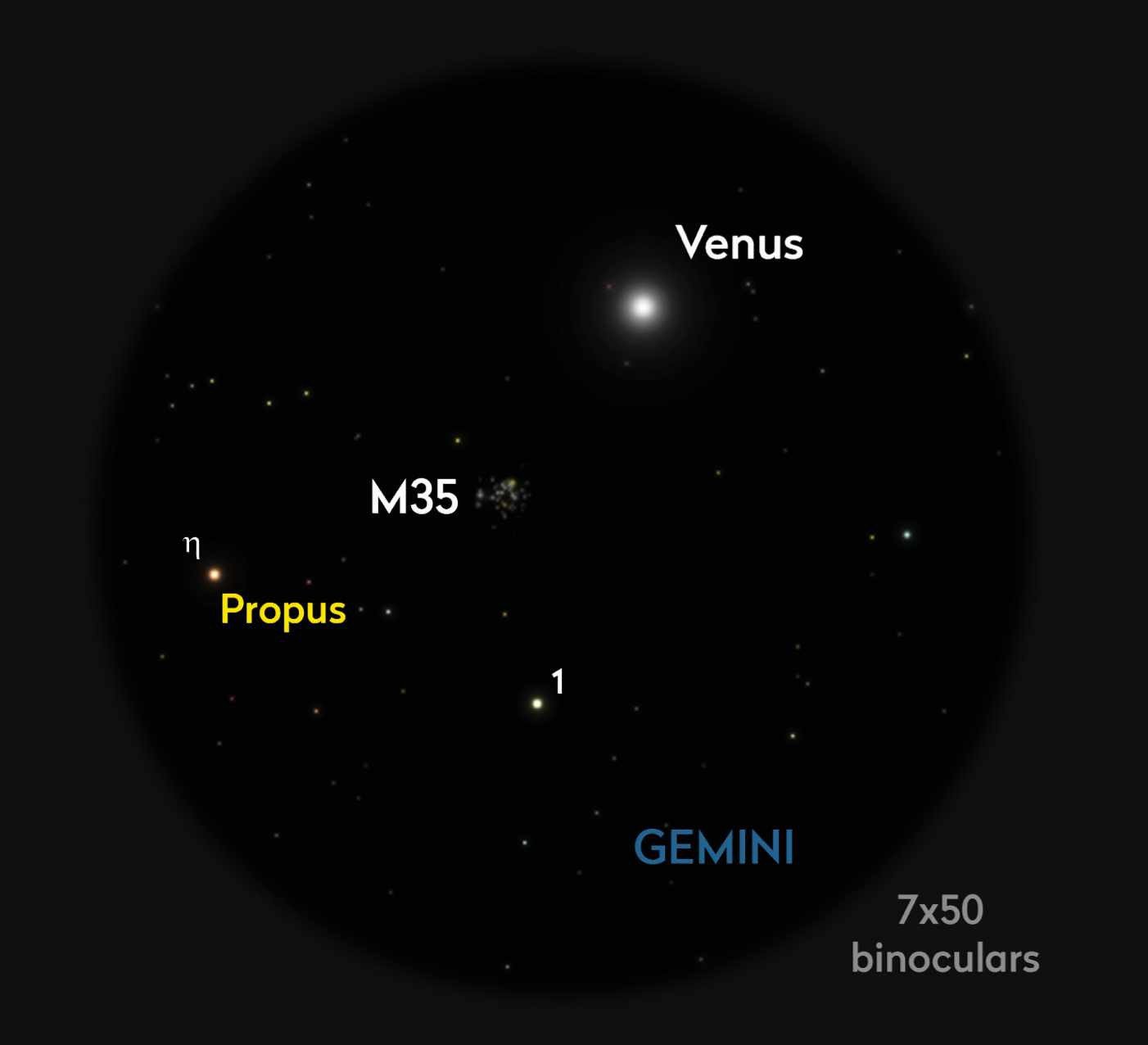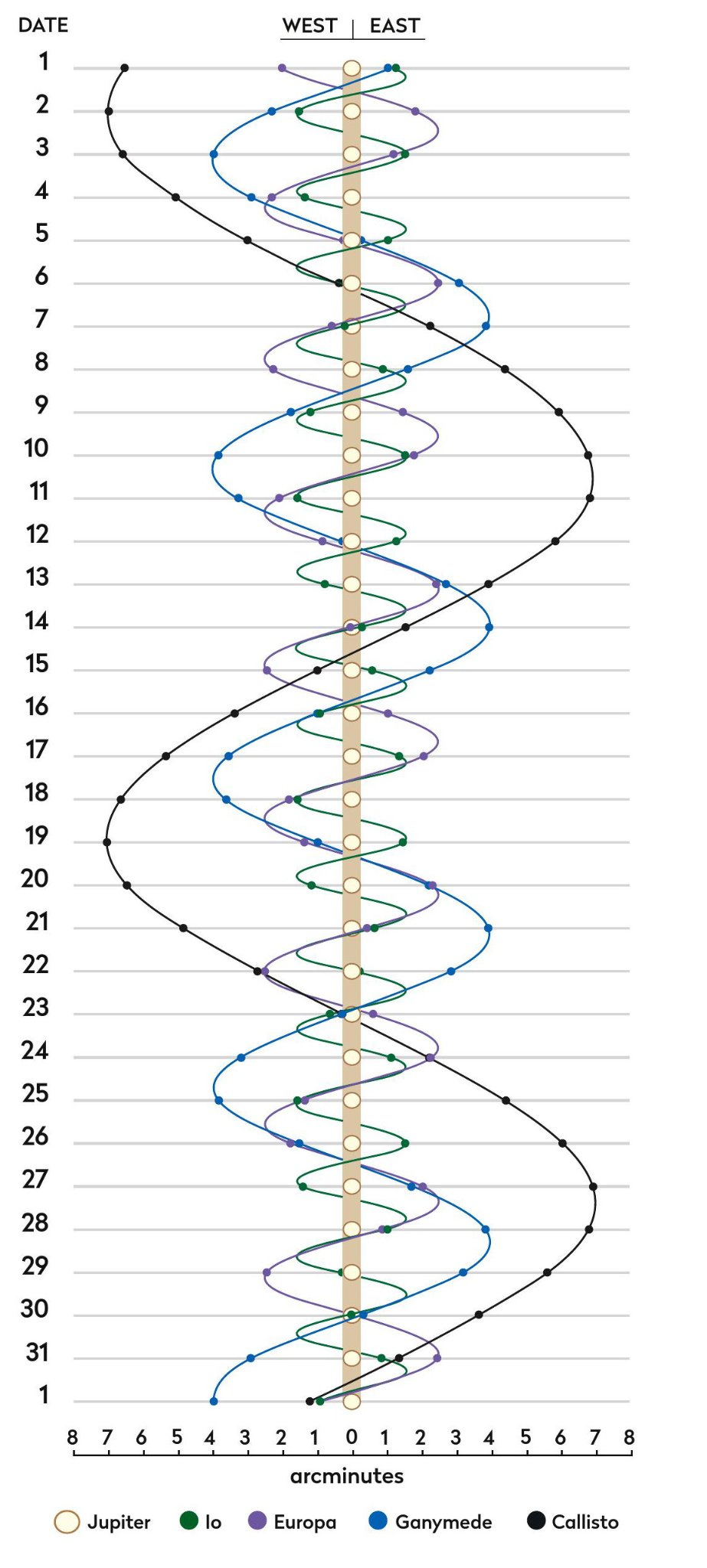Our celestial neighbourhood in May
PICK OF THE MONTH
Venus
Best time to see: 1 May, from 1 hour after sunset
Altitude: 24°
Location: Taurus
Direction: West-northwest
Features: Phase, subtle surface markings
Recommended equipment: 75mm or larger

Venus is a spectacular evening planet throughout May, despite its brilliance being constantly challenged by the bright, expanding spring evening twilight. On 1 May, shining at mag. –4.0, Venus sets 4 hours and 15 minutes after the Sun, giving you approximately 2 hours to view it against a dark sky as it approaches the northwest horizon.
On 9 May, now shining one-tenth of a magnitude brighter at –4.1, Venus sits 1.8° to the north of the mag. +5.1 open cluster M35 in Gemini. You’ll need a flat northwest horizon to see this encounter at its best though, as the pair are low when true darkness falls, about 8.5° as seen from the centre of the UK.
On 16 May, Venus sits three-quarters of a degree from Mebsuta (Epsilon (ε) Geminorum). All the while, the period when you are able to see Venus against a dark sky will be shrinking, the planet’s altitude decreasing significantly when true darkness falls throughout the month. Mid-month, Venus remains above the horizon for 4 hours after sunset and through a telescope appears 60%-lit. Its disc will appear nearly 20 arcseconds across on this date.
Venus’s monthly visit from the Moon is a two-evening affair during May. The mag. –4.1 planet has a visit from a 10%-lit waxing crescent Moon 6.8° to the right and slightly below it on the evening of 22 May, and a 17%-lit waxing crescent 4.8° east (above and left) of it on the evening of 23 May. On 31 May, the bright evening twilight starts to win against Venus and it will no longer be possible to see the planet against truly dark skies from the UK. On 31 May, Venus sets 3 hours 30 minutes after the Sun.
Mercury
Not visible
Mercury is at inferior conjunction on 1 May. Subsequently moving into the morning sky, it’s not well-placed, rising shortly before sunrise most of the month. By the end of May, Mercury shines at mag. +0.5, only rising 40 minutes before the Sun.
Mars
Best time to see: 1 May, from 23:00 BST (22:00 UT)
Altitude: 26°
Location: Gemini
Direction: West
Mars is a mag. +1.3 evening planet in Gemini on 1 May and through the month it loses altitude as darkness falls. On the evening of 23 May, mag. +1.5 Mars lies 14.5° west of mag. –4.1 Venus. A beautiful 17%-lit waxing crescent Moon sits between both planets. On the following evening, the 25%-lit waxing crescent Moon sits 3.2° above Mars. Both will be near the Beehive Cluster, M44, at this time, but late twilight and low altitude will make M44 hard to see. On 31 May, mag. +1.6 Mars knocks on the western side of M44, the cluster stars being really hard to see due to low altitude and bright twilight. Mars appears 4 arcseconds across at the end of May.
Jupiter
Best time to see: 17 May, from 14:20 BST (13:20 UT)
Altitude: 35°
Location: Pisces
Direction: Southwest (daylight)
Jupiter was in conjunction with the Sun last month and isn’t well-placed. Your best chance of spotting it will be in the early morning dawn twilight, low above the east-northeast horizon at the end of the month.
On the morning of 17 May, a slender 7%-lit waning crescent Moon sits 5° southwest of mag. –1.9 Jupiter as they both rise above the east-northeast horizon 50 minutes before sunrise. Stay with the Moon after sunrise using a telescope and it may also be possible to maintain a ghostly view of Jupiter. The Moon continues to close in on the planet, occulting it as seen from northern UK, or passing just to the north of it as seen from southern UK.
Saturn
Best time to see: 31 May, from 03:00 BST (02:00 UT)
Altitude: 6° (low)
Location: Aquarius
Direction: East-southeast
Low in the east-southeast, Saturn is visible in the dawn twilight. It is currently a morning object, not well-placed. The best time to see it is at the end of the month when, under brightening twilight, it reaches around 12° above the southeast horizon. When solar conjunctions occur before or around the June solstice, as is currently the case, the re-emergence of the main planets from the Sun’s glare tends to be poor. More encouragingly, the 2023 oppositions of Jupiter and Saturn are looking promising, with relatively good altitude.
Uranus
Not visible
Uranus is in conjunction with the Sun on 9 May and not currently visible.
Neptune
Not visible
Neptune is a morning object lost in the dawn twilight.
More ONLINE
Print out observing forms for recording planetary events
www.skyatnightmagazine.com/bonus-content/KZRG5FS
The planets in May
The phase and relative sizes of the planets this month. Each planet is shown with south at the top, to show its orientation through a telescope

JUPITER’S MOONS: MAY
Using a small scope you can spot Jupiter’s biggest moons. Their positions change dramatically over the month, as shown on the diagram. The line by each date represents 01:00 BST (00:00 UT).
